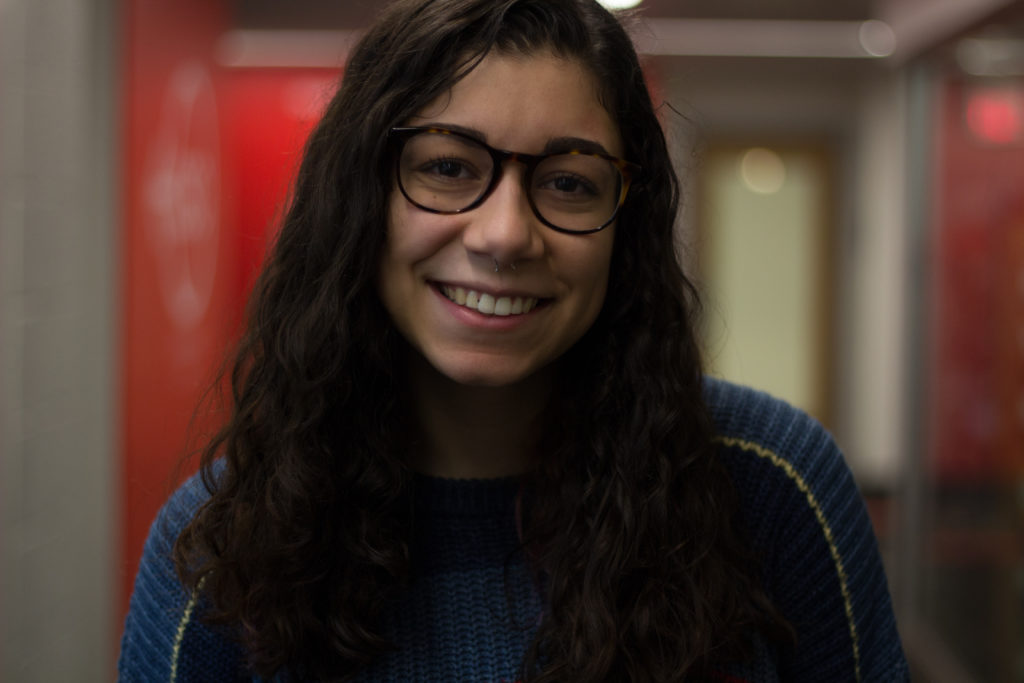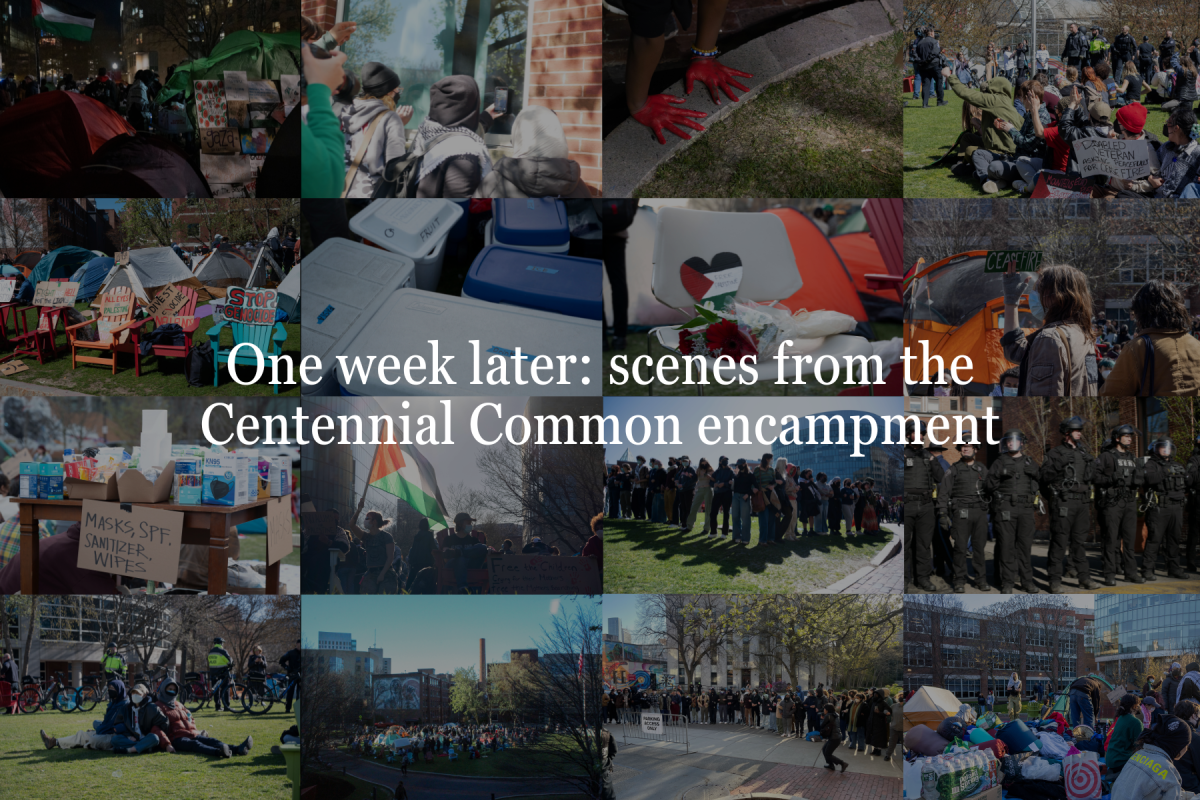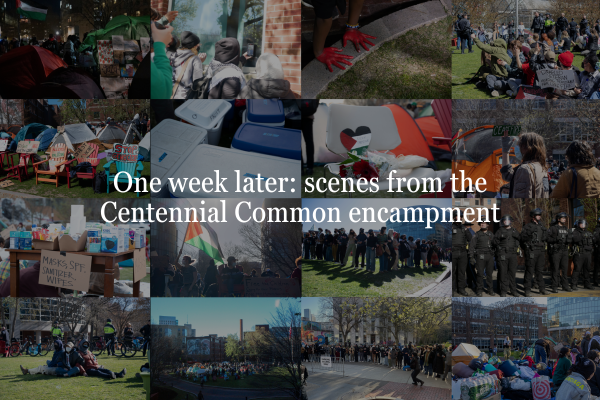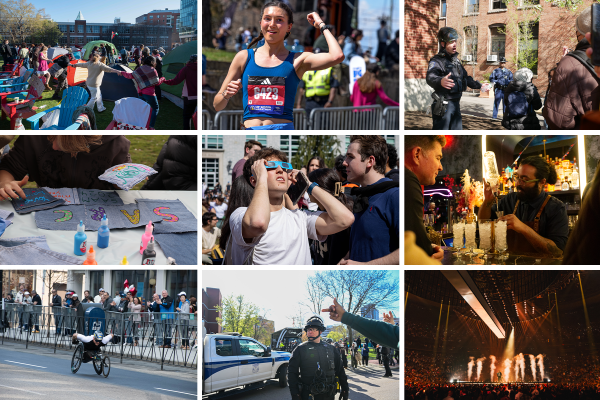Stigma against mental illness is decreasing on college campuses
November 29, 2018
As Mallory Gothelf inched through her freshman year at Northeastern University, it became increasingly difficult for her to manage her anxiety and depression. The transition to a university far from her home in Maryland had been difficult — she’d left behind her therapist, psychologist and support system of friends and family.
Gothelf, a brown-eyed, curly-haired and then-enthusiastic psychology student befriended a classmate and confided in them about her intensifying depression. The classmate called Northeastern’s health center and told them Gothelf was a threat to herself. But Gothelf, who feared the repercussions of telling university personnel about her worsening condition, said she couldn’t let herself be “turned in.”
“I picked up their call and told them that she was lying,” Gothelf said.

This incident caused her to put off getting the help she needed, she said. Though the classmate likely thought she did the right thing, her lack of understanding alienated Gothelf and worsened her condition.
“I’ve never heard from her since. And I have no idea where she went,” Gothelf said. “And it doesn’t bother me anymore, but in the moment I felt like she just assumed — people jump from ‘I have depression, I’m feeling unstable’ to ‘This girl’s going to kill herself, she’s mentally unstable, I can’t talk to her anymore.’”
Now a Northeastern alum, Gothelf is one of nearly 22 percent of the U.S. population between the ages of 18 and 25 who suffers from mental illness, according to the 2015 National Survey on Drug Use and Health. This is higher than any other age group, and the numbers continue to rise. Despite the prevalence of mental illness, there remains a stigma around the topic: According to the 2016-2017 Healthy Minds Survey, which aims to provide a detailed picture of mental health among college student populations, 47 percent of college students agreed that most people would think less of someone who has received mental health treatment.
This number is striking compared to the mere 6 percent of students who say they personally would think less of someone for receiving mental health treatment. This disparity shows that negative attitudes surrounding mental illness, at least in college settings, are primarily perceived and not often based on true animosity.
Laura Horne, the national director of programs at mental health advocacy group Active Minds, said this statistic shows students at the very least know they’re not supposed to think less of someone for seeking help.
“That in and of itself is good news because I think that means that people understand more about the kind of burden that people with mental illness are holding and that they should be able to get help without stigma,” Horne said.

Where, then, does the perception of negative attitudes toward mental illness stem from? Researchers, mental health advocates and students living with mental illness say the answer is widespread silence on the topic.
When Gothelf started sharing her story, she thought she would face judgement from her peers. She first spoke publicly about her experiences at an event called “Break the Silence,” hosted biannually by Northeastern’s chapter of Active Minds, which serves as a platform for students to talk about their struggles with mental illness in front of a larger audience.
Gothelf shared a video of her speech on social media. Shortly after, her inboxes filled with messages from people saying “I had no idea you went through that,” “You’re so brave” and “You’re so strong.” Some also messaged her saying they had gone through similar experiences and were afraid to talk about it, but wanted to open up after hearing her speak.
“That was such a powerful moment for me to know that other people who I had known for years were struggling,” Gothelf said. “We could have been struggling at the same time, but because we weren’t talking about it, I had no idea and they had no idea. Me sharing gave them the feeling that they could share. That made me realize that, one, I have a voice that I need to use, and two, that this is something I should never stop talking about.”
The disconnect: perceived and personal stigmas
The disconnect between perceived and actual antipathy toward mental illness is not entirely new. The Healthy Minds Survey, which has been collecting some of the most comprehensive data on campus mental health since 2007, has documented similar gaps since its first year.
Still, rates of both personal and perceived stigma are falling: The 6 percent figure in 2017 is down from more than 11 percent in 2007, marking a near-halving in the number of students who reported negative opinions toward people who seek treatment for mental illness.
Peter Ceglarek, one of the survey’s coordinators, says this is fascinating.
“The plus side is we’ve reached a point where it seems like individually stigmatizing beliefs are decreasing, so students themselves are feeling more open and accepting toward people struggling with mental health issues,” he said. “However, there’s some disconnect in that the perceived cultural norm is still that most people aren’t okay with it.”
This negative perception can be exacerbated in students with a mental illness such as anxiety, which New Jersey-based social worker Audrey Mayer said is characterized by symptoms that cause those students to “look at it through that lens that they would be judged.”
“Somebody with anxiety and depression may presume that they would be harshly judged for seeking help, but somebody more stable would just understand that they need the help,” she said.
Still, Horne said silence is a big reason students still feel like there’s a long way to go to reduce stigma on their campuses.
In turn, the lack of conversation surrounding mental illnesses can cause students struggling with them to feel more alone.
“I think on college campuses people don’t talk about it and people aren’t getting help,” Gothelf said. “Because people aren’t talking about it, people have to hide and things keep building up … It makes you feel so alone in your battle and as though no one understands. And isolation breeds depression so the more lonely you feel, the worse your depression is going to get.”
Gothelf said after tragic events on campus, such as student suicides, community members rally around the idea that they should tell people “It’s okay to get help.” But the energy toward this cause is fleeting, and once the sting of a suicide has faded, the conversation falls flat as quickly as it surfaced.
“Because we’re not continuing this conversation, the people who are still struggling still don’t think it’s okay to get help,” she said.
Advocacy groups, then, must look at ways to encourage more students to speak openly about mental illness.
“If people aren’t thinking less of others for seeking help, we need them to be saying that out loud,” Horne said.
Ceglarek agreed that mental health advocacy groups should focus more on opening a conversation and sending the message to students with mental illnesses that a majority of their peers will not judge them.
“Those two numbers should match in an ideal world, you know: 6 percent of people hold the beliefs and only 6 percent of people think that other people around them hold negative beliefs,” Ceglarek said. “But there’s a great disparity, so to make those two match we need to shift our conversation around stigma.”
“I think maybe shifting our messaging a little bit so that we give a voice to people who want to see their friends get help, allies and really engage them,” Horne said. “It’s not a normal conversation yet to have in the same way that if we were physically ill we would talk about it.”
Living with the inevitable
When Gothelf was a sophomore in high school, something felt off.
“Not just the normal growing up; something felt really off,” she said. “I started to realize this feeling wasn’t right, but I’m kind of a perfectionist so I didn’t want to admit I had a flaw or there was something wrong with me.”
However, her friend knew. And when Gothelf began harming herself, that friend showed up at her house and said she had to tell her parents. When her mother found out she was considering killing herself, they spent Christmas Day in the Johns Hopkins University emergency room. Gothelf was eventually diagnosed with major depressive disorder and generalized anxiety disorder and has since been in and out of treatment, even taking a medical leave of absence from Northeastern to get back on track.
“Every day is a battle,” Gothelf said. “Every day I don’t know how I’m going to wake up and how I’m going to feel … some days I hop right out of bed all inspired to go make a difference and other days it is literally me dragging myself out of bed and saying ‘you have to push through’ in order to get through my day.”
The impact of negative stigma can be crippling. The 2017 Healthy Minds Survey shows that 43 percent of students experiencing symptoms of anxiety or depression never sought treatment. Among students who have, 35 percent say they sought fewer services because they don’t need them and 35 percent say they do not have enough time to pursue treatment. Ceglarek says it’s likely that stigma influences these and other barriers to students seeking help.
“When you try and unpack these, there is a strong likelihood that the influences on some of these ideas is still the worry that so many people out there are still going to think negatively of you if you seek treatment, especially when someone is saying ‘Oh, I’d rather just deal with it on my own,’” Ceglarek said. “If you’re dealing with it on your own, that means you never have to talk to someone else about it. That means no one has to know what you’re going through.”
Jenna Malley, a 2018 alum of Northeastern’s accelerated master’s program, was diagnosed with anxiety and depression during her first year of college alongside her best friend.
“We really relied on each other to get through our freshman year of college,” she said of the longtime friend who attended Stonehill College in Easton, Massachusetts. When they saw each other the following summer, Malley said, “It seemed like everything was fine.”
But two weeks before Malley returned to Northeastern and one week before her friend was supposed to return to Stonehill, she read a story in the news about an accident in the New Jersey town neighboring her own.
“I found out that my best friend had died by suicide,” she said. “That was probably one of the most traumatic experiences of my life.”
In the following year, Malley said she realized she didn’t have any friends left at school — no one was willing to help her deal with her grief, or no one knew how.
“It also felt like it was because it was a loss to mental illness that they just didn’t want to deal with it,” Malley said. “I actually had someone tell me that she would rather go out to parties than deal with somebody that was going through what I was going through.”
Malley was afraid to go to University Health and Counseling Services because she didn’t want people to question why she was there, and she was afraid to go to counseling off-campus in case she had to miss class and get a doctor’s note from a psychiatrist.
“It’s not something I felt comfortable with because I just assumed that people were going to have this negative reaction because there’s so much stigma surrounding mental illness and suicide,” she said.

The fear that a doctor’s note from a psychologist would raise eyebrows is concerning, but not unique. Many students with mental illness believe their conditions will not be taken as seriously as physical health issues typically are. Whenever Gothelf had a panic attack or was in the midst of a depressive episode, she felt she had to lie to professors and say she had a cold or the flu to legitimize her absence.
“It’s upsetting and it’s extremely frustrating,” Gothelf said. “I think it’s also kind of demeaning because this is a very real illness. I wake up every morning knowing that I’m going to be anxious for no particular reason, that’s just the way my anxiety works.”
Gothelf’s anxiety makes her heart race, which over an extended period of time also makes her nauseous: physical implications of her mental illness which she never believed would qualify as valid reasons to miss class or work.
Others’ doubts make Gothelf doubt herself, as well. She said thoughts occasionally surface that she could be making up the condition, and maybe it’s all in her head.
“It makes me doubt all the things that I’ve been working so hard to break in that stigma,” she said.
Efforts and effectiveness
Horne said even in her role as a supervisor for a mental health organization, she has failed to notice when her coworkers and people she supervises are struggling with mental health.
“There weren’t a lot of tools for me. There weren’t a lot of policies in place or supports in place or precedents for how to support your employee,” she said. “I think we see things, we see signs and symptoms, and we might assume that person is just disinterested or lazy or unproductive, but we don’t usually take a step back and consider that there might be something real that that person is dealing with.”
To ensure more people do take mental health into consideration, Active Minds and other organizations are working to raise awareness and erase stigma through education and silence-breaking.
Active Minds organizes young adults who have personal experiences with mental illness to travel to college campuses around the country and talk about those experiences. They also organize an exhibition called “Send Silence Packing,” of backpacks, each representing a college student who died by suicide and accompanied by their story.
“You walk through the exhibit and you read these stories, and you understand — for the first time, maybe — just how unfortunate it is that many people who died by suicide have mental illness and it’s treatable,” she said. “So that also starts a conversation and gives a voice to all of these stories and the people who have died.”
Horne said the most successful thing Active Minds has created is of set of tools and resources called “Transform Your Campus” which aims to help students advocate for policy and systems change on their own campuses and provides a template for them to implement mental health education.
“All of these efforts combined at Active Minds are meant to help start conversations, help break that silence on campus and help make it easier and more normalized and more part of what it is to be a college student to use counseling services just like you would academic services or disability services,” she said.
Students are also taking the issue of stigma into their own hands. In spring 2017, Malley created the AMAZING Campaign in memory of her friend who died by suicide. Through the campaign, she sells t-shirts that have “AMAZING” printed backward on them, so when people wear them and look in the mirror they see that they are amazing. Proceeds from the shirts go toward the National Foundation for Suicide Prevention, while the shirts themselves start conversations.

“Our whole goal is to raise awareness of mental illness, raise awareness for suicide prevention and really just tell people that they’re not alone in what they’re dealing with,” Malley said. “Our hope is that anyone wearing the AMAZING campaign shirts will feel comfortable talking about it. If somebody sees it and is like ‘Why is amazing backward on your shirt?’ people will actually start a conversation.”
Additionally, in 2016, several Northeastern students who wanted to create a space on campus to talk openly about mental health issues founded Behind the SMILE. The club is devoted to advocacy and awareness, and hosts discussion-based meetings for students to express anything they feel without judgement.
Among the founders was Izzie Irizarry, a fifth-year psychology major and the club’s former vice president. In 2017, she organized the first “Out of the Darkness” walk at Northeastern, a fundraiser similar to “Relay for Life” that instead raises money for the American Foundation for Suicide Prevention.
Irizarry said Behind the SMILE members were excited about the message the walk sent to the Northeastern community as the first large-scale event dedicated to suicide prevention on campus. She organized a second Out of the Darkness walk this past April.
“We felt like it really just showed that a lot of people cared,” she said. “People outside looking in see that a lot of people care about mental illness, a lot of people also have experiences, it’s okay to have these experiences as well because you’re not alone. And then the people who participate also find a lot of community in seeing that there are people who share their passion for the issue.”

It is these grassroots movements that are changing the national conversation. Gothelf said members of mental health advocacy groups are almost always sympathetic to the cause already because of their own experiences with mental illness, but said the culture is shifting. In her own conversations among friends who have never dealt with mental illness, she said opening up and explaining her experiences really changes their perspectives.
“I really do think that it’s the small efforts to keep talking that are starting to shift the perspective,” Gothelf said. “I say it comes from grassroots movements and I do really mean that, and as these grassroots movements gain national spotlight attention, I think then they are getting a bigger push as they’re growing on campuses and throughout society.”


















